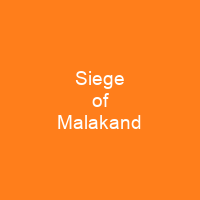The Siege of Malakand: A Brief Overview
Imagine a small, seemingly insignificant event that could change the course of history. That’s exactly what happened during the siege of Malakand in 1897. This six-day conflict between British forces and Pashtun tribesmen led by Saidullah was more than just a skirmish; it was a pivotal moment in the Great Game, the geopolitical rivalry between Britain and Russia for control over Afghanistan.
The Context: The Great Game
Before diving into the details of this battle, let’s take a step back. In 1838, the British launched their First Anglo-Afghan War to impose a puppet regime under Shuja Shah. But as history often shows us, such attempts are fraught with complications and short-lived results. After tensions rose again in 1878, the Durand Line was imposed in 1893 to serve as a buffer zone against Russian influence. This line, while intended to create a barrier, only served to heighten the tension between the two empires.
The Prelude: Unrest and Warning
On July 26, 1897, the British garrison in Malakand received a warning that something was brewing. Major Deane warned his officers of growing unrest among Pashtun sepoys on July 23. Rumors circulated about a new religious leader, Saidullah the Sartor Fakir (Mullah of Mastun), who would inspire jihad against the British.
The Battle: A Day-by-Day Account
On the night of July 26/27, a messenger arrived with word that the enemy had reached Khar. The British camp at South Malakand was attacked by Pashtun tribesmen, who were repelled after a fierce fighting withdrawal and counterattack by Lieutenant-Colonel McRae and Major Taylor. Other units were also assaulted, including the 24th Punjab Infantry’s picket lines, which were quickly overrun.
During the night of July 26/27, Pashtun sharpshooters inflicted casualties throughout the night, and the bazaar was occupied. The next day, fresh Pashtun attacks were repulsed by elements of the 24th under Climo. At night, many thousands of rounds were discharged, and several hours of defense were undertaken by Subadar Syed Ahmed Shah’s forces.
On July 28, continuous fire from Pashtun sharpshooters surrounded the British garrison. Despite further attacks, only two killed were reported among the sepoy ranks, and Lieutenant Ford was severely wounded. On July 29-31, communication was re-established, and the approaching relief forces were signalled via heliograph.
The last remaining British units arrived at Malakand South on July 27, coinciding with Pashtun reinforcements. The sepoys of the 11th Bengal Lancers awoke to news describing the situation and set off to relieve the besieged garrison. What ammunition are you bringing? When may we expect you?
During the day, the Pashtuns prepared for another night attack while the British destroyed the bazaar and cut down trees to improve fields of fire, attracting further attention from the Pashtun sharpshooters.
The Relief: A Turning Point
Major Stuart Beatsen arrived at 4:00 pm on the 29th with the 11th Bengal Lancers. The 35th Sikhs and 38th Dogras arrived later but were forced to halt due to heat exhaustion.
The Pashtuns launched another attack on July 30, during which Costello and the Pashtun Mullah were wounded, as well as a British fatality among the sepoy contingent. A bayonet charge of the 45th Sikhs repulsed a further attack that evening.
On July 31, the remainder of the 38th Dogras and 35th Sikhs entered Malakand South under Colonel Reid’s command, bringing ammunition with them. The British outpost of Chakdara received attention from the Pashtuns, leading to a reduction in attacks on Malakand South.
The Aftermath: A New Chapter
Major-General Sir Bindon Blood arrived at Nowshera on July 31 and took command of the relief force. He was informed that the Pashtun forces had turned their attention to Chakdara, a small under-garrisoned fort with few supplies. Blood marched towards Chakdara from the main camp at Nowshera while Meiklejohn set out with a rescue force.
The rescue column successfully broke out of the Pashtun encirclement on August 2, leading to confusion among the Pashtun forces. The British recorded 33 casualties from the action on that day.
Legacy: Churchill’s First Combat Experience
Immediately after the siege, two brigades of the British garrison were relocated to a new camp to relieve pressure in Malakand South. The campaigns continued beyond the siege, with Saidullah rallying his surviving Pashtun forces and attacking the British garrison at Shabkadr fort near Peshawar on August 8.
These attacks put the continued loyalty of friendly Pashtun levies guarding the British supply lines to Chitral at risk, thus endangering the supply convoys and their small escorts. In response, on 14 August, the British advanced farther into Pashtun territory and engaged a force of ‘several thousand’ Pashtun tribesmen, with General Meiklejohn leading a flanking manoeuvre which split the Pashtun army in two, forcing it to pull back to Landakai. The British continued to engage Pashtun tribesmen throughout the day, suffering two officers and 11 other ranks killed.
The siege of Malakand was Winston Churchill’s first experience of actual combat, which he later described in several columns for The Daily Telegraph, receiving £5 per column; these articles were eventually compiled into his first published book, The Story of the Malakand Field Force, beginning his career as a writer and politician.
War Office authorized the award of the clasp Malakand 1897 to the India Medal for those of the British and Indian armies who participated in this action. The siege of Malakand, though brief, was a significant event that marked Churchill’s entry into military history and his subsequent rise as a political figure.

You want to know more about Siege of Malakand?
This page is based on the article Siege of Malakand published in Wikipedia (retrieved on November 28, 2024) and was automatically summarized using artificial intelligence.







